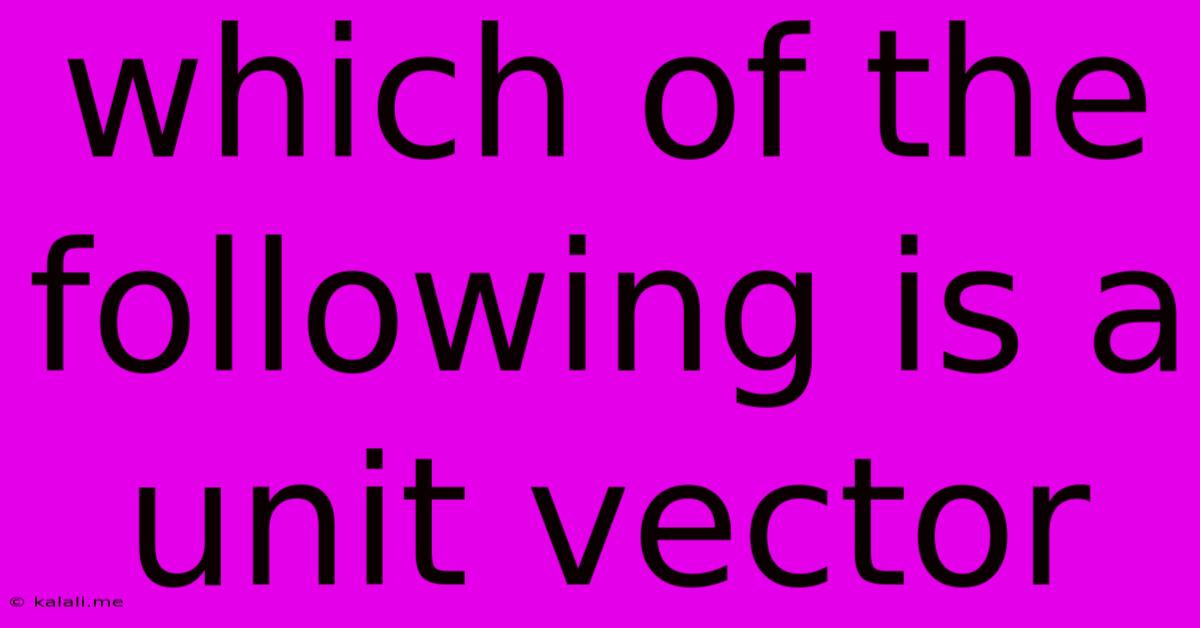Which Of The Following Is A Unit Vector
Kalali
Jun 15, 2025 · 3 min read

Table of Contents
Which of the Following is a Unit Vector? Understanding Vectors and Magnitude
This article will explore the concept of unit vectors and how to identify them. We'll break down the definition, provide examples, and show you how to determine if a given vector is a unit vector. Understanding unit vectors is crucial in various fields like linear algebra, physics, and computer graphics.
What is a Unit Vector?
A unit vector is a vector with a magnitude (or length) of exactly 1. It's often used to represent direction, as its length is normalized to one, leaving only the direction information. This makes them incredibly useful for representing directions in various coordinate systems. Think of it like a compass needle – it always points in a specific direction, regardless of how long the needle itself is.
Calculating the Magnitude of a Vector
Before we can determine if a vector is a unit vector, we need to understand how to calculate its magnitude. For a vector represented in Cartesian coordinates as v = (v<sub>x</sub>, v<sub>y</sub>, v<sub>z</sub>), the magnitude (often denoted as ||v|| or |v|) is calculated using the Pythagorean theorem in three dimensions:
||v|| = √(v<sub>x</sub>² + v<sub>y</sub>² + v<sub>z</sub>²)
For a two-dimensional vector v = (v<sub>x</sub>, v<sub>y</sub>), the formula simplifies to:
||v|| = √(v<sub>x</sub>² + v<sub>y</sub>²)
Identifying a Unit Vector
Now, let's get to the core question: how do we identify a unit vector? Simple: A vector is a unit vector if and only if its magnitude is equal to 1.
Let's look at some examples:
-
Example 1: Vector a = (1, 0, 0)
- ||a|| = √(1² + 0² + 0²) = 1. Therefore, a is a unit vector.
-
Example 2: Vector b = (0.5, 0.866)
- ||b|| = √(0.5² + 0.866²) ≈ 1. Therefore, b is approximately a unit vector (rounding errors might slightly alter the result).
-
Example 3: Vector c = (2, 3)
- ||c|| = √(2² + 3²) = √13 ≠ 1. Therefore, c is not a unit vector.
-
Example 4: Vector d = (0, 1, 0)
- ||d|| = √(0² + 1² + 0²) = 1. Therefore, d is a unit vector.
Normalizing a Vector to Create a Unit Vector
If you have a vector that is not a unit vector, you can create a unit vector pointing in the same direction by normalizing it. This involves dividing each component of the vector by its magnitude:
û = v / ||v||
Where û is the unit vector and v is the original vector.
Applications of Unit Vectors
Unit vectors are fundamental in many areas:
- Direction Cosines: The components of a unit vector represent the direction cosines.
- Physics: Representing directions of forces, velocities, and accelerations.
- Computer Graphics: Defining directions of light sources and camera orientations.
- Linear Algebra: Basis vectors in a coordinate system are often unit vectors.
In conclusion, identifying a unit vector is straightforward: calculate its magnitude. If the magnitude equals 1, it's a unit vector. Understanding unit vectors is essential for anyone working with vectors and their applications. Remember to always consider rounding errors when dealing with decimal values.
Latest Posts
Latest Posts
-
Which Of The Following Is A Non Renewable Resource
Jun 15, 2025
-
What Is A Major Element Found In Bones
Jun 15, 2025
-
What Is The Storage Form Of Glucose In Plants
Jun 15, 2025
-
Which Is Heavier Kilograms Or Pounds
Jun 15, 2025
-
Identify The True And False Statements About Survey Research
Jun 15, 2025
Related Post
Thank you for visiting our website which covers about Which Of The Following Is A Unit Vector . We hope the information provided has been useful to you. Feel free to contact us if you have any questions or need further assistance. See you next time and don't miss to bookmark.